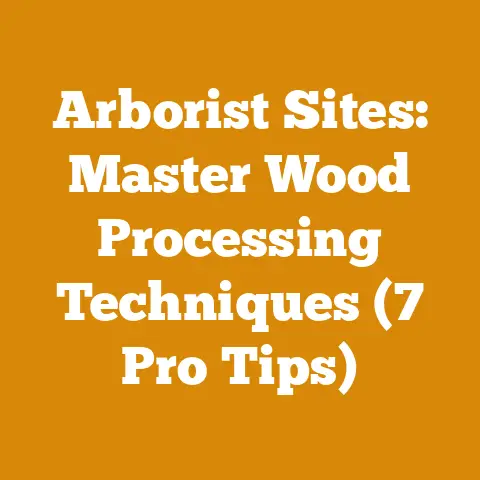Wood Treatment for Ground Contact (5 Pro Tips for Lasting Durability)
Let’s talk about wood that’s going to touch the ground.
We’re not just talking about firewood here (though that’s definitely a part of it!), we’re talking about fence posts, raised garden beds, decks, structural supports – anything where wood meets terra firma.
And let me tell you, that direct contact is a recipe for disaster if you don’t take the right precautions.
Why should you care?
Well, beyond the obvious (rotting wood is weak wood), consider the long-term implications.
If you’re building something on your property, you’re investing in its value.
A rotting deck detracts from that value.
Properly treated wood, on the other hand, ensures your investment lasts, and can even increase the resale value of your home.
Think about it: a potential buyer is much more likely to be impressed by a well-maintained fence or deck than one riddled with rot and decay.
I’ve seen firsthand the consequences of neglecting proper wood treatment.
A friend of mine built a beautiful pergola in his backyard, using untreated lumber for the posts.
Within just a few years, the base of the posts started to crumble.
He ended up having to replace the entire structure, a costly and time-consuming mistake that could have been avoided with proper ground contact wood treatment.
So, let’s dive into the pro tips that will save you time, money, and a whole lot of headaches down the road.
Wood Treatment for Ground Contact: 5 Pro Tips for Lasting Durability
1. Choosing the Right Wood: It All Starts with the Source
It might seem obvious, but selecting the right type of wood is the absolute foundation for any ground contact project.
Not all wood is created equal, and some species naturally resist rot and decay far better than others.
This isn’t just about aesthetics; it’s about longevity and structural integrity.
Naturally Durable Wood Species: These woods contain natural oils and compounds that make them resistant to insects and decay.
- Redwood: A classic choice, redwood is known for its beautiful color and natural resistance to rot and insects.
However, old-growth redwood is increasingly rare and expensive. - Cedar (Western Red Cedar, Eastern White Cedar): Cedar is another excellent choice, offering similar resistance to redwood but often at a lower price point.
It’s also lightweight and easy to work with.
Western Red Cedar is generally considered more durable than Eastern White Cedar. - Black Locust: This North American hardwood is incredibly durable and rot-resistant, often used for fence posts and other ground contact applications.
It’s also incredibly strong. - Osage Orange (Hedge Apple): Known for its extreme density and rot resistance, Osage Orange is a top choice for fence posts.
However, it can be difficult to work with due to its hardness. - Ipe (Brazilian Walnut): This exotic hardwood is incredibly dense and durable, making it an excellent choice for decking and other high-traffic areas.
However, it’s also very expensive and can be challenging to work with.
- Redwood: A classic choice, redwood is known for its beautiful color and natural resistance to rot and insects.
Less Durable Wood Species: These woods are more susceptible to rot and insect damage and require treatment for ground contact applications.
- Pine (Southern Yellow Pine, White Pine): Pine is readily available and relatively inexpensive, but it’s not naturally durable.
It requires pressure treatment for ground contact. - Fir (Douglas Fir): Similar to pine, fir is also widely used but needs treatment for outdoor use.
- Poplar: A soft, fast-growing hardwood that’s inexpensive but not very durable.
It’s best used for interior applications or projects where it will be protected from the elements. - Spruce: Another common softwood that’s not naturally rot-resistant.
- Pine (Southern Yellow Pine, White Pine): Pine is readily available and relatively inexpensive, but it’s not naturally durable.
Data Point: A study by the Forest Products Laboratory found that untreated Southern Yellow Pine posts in ground contact lasted an average of 3-5 years, while Black Locust posts lasted 20-30 years.
This highlights the dramatic difference in durability between wood species.My Experience: I once used untreated pine for a raised garden bed, thinking I could get away with it.
Within two seasons, the wood started to rot, and the bed collapsed.
It was a frustrating experience that taught me the importance of choosing the right wood or properly treating it.Unique Insight: Consider the source of your lumber.
Locally sourced wood is often more sustainable and can be better suited to your local climate.
Talk to local sawmills or lumberyards to learn about the best options for your area.Actionable Takeaway: Before starting your project, research the durability of different wood species and choose one that’s naturally resistant to rot or is suitable for pressure treatment.
Don’t skimp on this step – it will save you money and headaches in the long run.
2. Pressure Treatment: The Gold Standard for Ground Contact
Pressure-treated wood is lumber that has been chemically treated to resist rot, decay, and insect infestation.
This process involves forcing preservatives deep into the wood fibers under high pressure, creating a protective barrier that extends throughout the entire piece.
Types of Preservatives:
- Alkaline Copper Quaternary (ACQ): A common preservative that’s effective against a wide range of fungi and insects.
It’s considered a safer alternative to older preservatives like CCA (Chromated Copper Arsenate). - Copper Azole (CA): Similar to ACQ, CA is another copper-based preservative that’s effective against rot and insects.
- Micronized Copper Azole (MCA): This is a newer generation of copper-based preservatives that uses micronized copper particles, allowing for better penetration and a more natural appearance.
- Borates: Borate preservatives are effective against insects and fungi, but they’re not as resistant to leaching as copper-based preservatives.
They’re often used for interior applications or in combination with other preservatives.
- Alkaline Copper Quaternary (ACQ): A common preservative that’s effective against a wide range of fungi and insects.
Understanding Treatment Levels: Pressure-treated wood is labeled with a retention level, which indicates the amount of preservative that has been absorbed into the wood.
For ground contact applications, you’ll typically need a retention level of .40 pounds per cubic foot (pcf) or higher.
For severe environments, such as saltwater or constantly wet conditions, a higher retention level may be required.-
Data Point: According to the American Wood Protection Association (AWPA), pressure-treated wood with a retention level of .40 pcf can last for 20-30 years or more in ground contact applications.
My Experience: I’ve used pressure-treated wood for numerous projects, including fence posts, decks, and retaining walls.
I’ve always been impressed with its durability and resistance to rot and insects.
I once built a deck using pressure-treated lumber, and after 15 years, it’s still in excellent condition.Unique Insight: When purchasing pressure-treated wood, look for the AWPA stamp, which indicates that the wood has been treated to industry standards.
Also, be sure to check the end tag for the retention level and intended use (e.g., ground contact, above ground).Safety Considerations: While modern pressure-treated wood is considered safer than older versions, it’s still important to take precautions when working with it.
Wear gloves and a dust mask when cutting or sanding pressure-treated wood, and dispose of scraps properly.
Do not burn pressure-treated wood, as the fumes can be toxic.Actionable Takeaway: For any project involving ground contact, use pressure-treated wood with a retention level of .40 pcf or higher.
Choose a preservative that’s appropriate for your climate and intended use.
Always follow safety precautions when working with pressure-treated wood.
3. Proper Drainage: Keeping Wood Dry is Half the Battle
Even with the most durable wood and the best treatment, moisture is still the enemy.
Wood rot thrives in damp environments, so ensuring proper drainage is crucial for extending the lifespan of your ground contact projects.
Elevating Wood from Direct Contact: Avoid direct contact between wood and soil whenever possible.
Use concrete footings, gravel beds, or plastic spacers to elevate the wood and allow for air circulation.Improving Soil Drainage: If your soil is poorly drained, consider adding gravel or sand to improve drainage around the wood.
You can also install drainage pipes to divert water away from the area.Creating a Moisture Barrier: Use a waterproof membrane or sealant to create a barrier between the wood and the soil.
This will help prevent moisture from wicking up into the wood.Designing for Ventilation: Design your project to allow for adequate ventilation.
This will help the wood dry out quickly after rain or snow.
For example, when building a deck, leave small gaps between the boards to allow for air circulation.-
Data Point: A study by the University of Minnesota found that wood that was elevated just a few inches above the ground lasted twice as long as wood that was in direct contact with the soil.
My Experience: I learned the importance of proper drainage the hard way.
I once built a fence without properly preparing the soil, and the posts started to rot within a few years.
I had to replace the posts and install drainage pipes to prevent the problem from recurring.Unique Insight: Pay attention to the slope of your land.
Make sure that water flows away from your project, not towards it.
You may need to regrade the area to ensure proper drainage.Case Study: A homeowner in Seattle, Washington, was experiencing premature rot in their deck posts.
The problem was that the posts were set directly into the ground, and the soil was constantly damp due to the region’s high rainfall.
To solve the problem, the homeowner replaced the posts with pressure-treated lumber and set them on concrete footings.
They also installed a drainage system to divert water away from the deck.
As a result, the new posts are expected to last much longer.
Equipment used: Post hole digger, concrete mixer, pressure-treated lumber, concrete footings, drainage pipes.
Wood type: Pressure-treated Douglas Fir.
Safety considerations: Wear safety glasses and gloves when working with concrete and pressure-treated lumber.Actionable Takeaway: Before starting your project, assess the drainage in your area and take steps to improve it.
Elevate wood from direct contact with the soil, create a moisture barrier, and design for adequate ventilation.
4. Sealing and Coating: Adding an Extra Layer of Protection
While pressure treatment provides a good level of protection, adding a sealant or coating can further extend the lifespan of your ground contact projects.
These products create a barrier against moisture, UV rays, and other environmental factors that can damage wood.
Types of Sealants and Coatings:
- Water Repellents: These products help prevent water from penetrating the wood, reducing the risk of rot and decay.
They’re typically clear and easy to apply. - Stains: Stains add color to the wood while also providing some protection against moisture and UV rays.
They’re available in a wide range of colors and opacities. - Paints: Paints provide a durable, opaque finish that protects the wood from moisture, UV rays, and abrasion.
However, they can also trap moisture inside the wood if not applied properly. - Epoxy Coatings: Epoxy coatings are extremely durable and waterproof, making them an excellent choice for ground contact applications.
However, they can be expensive and require specialized application techniques. - Borate-Based Wood Preservatives: These can be applied as a topical treatment to further protect the wood, especially at cut ends.
- Water Repellents: These products help prevent water from penetrating the wood, reducing the risk of rot and decay.
Choosing the Right Product: The best sealant or coating for your project will depend on the type of wood, the climate, and your desired aesthetic.
Consider the following factors:- Water Resistance: Choose a product that’s specifically designed to repel water.
- UV Protection: Look for a product that contains UV inhibitors to protect the wood from sun damage.
- Durability: Choose a product that’s durable and long-lasting.
- Ease of Application: Consider how easy the product is to apply and maintain.
- VOC Content: Choose a product with low VOCs (volatile organic compounds) to minimize environmental impact.
-
Data Point: A study by the USDA Forest Service found that wood treated with a water repellent lasted up to 50% longer than untreated wood in outdoor applications.
My Experience: I’ve used various sealants and coatings on my wood projects, and I’ve found that a good quality water repellent can make a significant difference in the wood’s longevity.
I always apply multiple coats, especially to the end grain, which is more susceptible to moisture penetration.Unique Insight: Before applying a sealant or coating, make sure the wood is clean and dry.
Remove any dirt, debris, or mildew.
You may also need to sand the wood to create a smooth surface.Case Study: A homeowner in Florida was experiencing premature fading and cracking in their wooden fence.
The problem was that the fence was exposed to intense sunlight and humidity.
To solve the problem, the homeowner applied a stain with UV inhibitors and a water-repellent sealant.
They reapplied the sealant every year to maintain the protection.
As a result, the fence is now protected from the elements and is expected to last much longer.
Equipment used: Paintbrushes, rollers, sandpaper, stain, sealant.
Wood type: Cedar.
Safety considerations: Wear safety glasses and gloves when working with stains and sealants.Actionable Takeaway: Protect your ground contact projects with a sealant or coating.
Choose a product that’s appropriate for your wood type, climate, and desired aesthetic.
Apply multiple coats, especially to the end grain.
Reapply the sealant or coating regularly to maintain the protection.
5. Regular Maintenance: Prevention is Better (and Cheaper) than Cure
Even with the best wood, treatment, drainage, and sealant, regular maintenance is essential for ensuring the long-term durability of your ground contact projects.
By inspecting and maintaining your wood regularly, you can identify and address potential problems before they become major issues.
Regular Inspections: Inspect your wood projects at least twice a year, preferably in the spring and fall.
Look for signs of rot, decay, insect damage, or water damage.
Pay close attention to areas that are in contact with the ground or are exposed to moisture.Cleaning: Clean your wood projects regularly to remove dirt, debris, and mildew.
Use a mild soap and water solution and a soft brush.
Avoid using harsh chemicals or power washers, as they can damage the wood.Repairing Damage: Repair any damage promptly.
Replace rotted or damaged wood, tighten loose fasteners, and repair cracks or splits.Reapplying Sealant or Coating: Reapply sealant or coating every year or two, or as needed.
This will help maintain the protection against moisture, UV rays, and other environmental factors.Removing Debris: Keep the area around your wood projects clear of debris, such as leaves, branches, and mulch.
These materials can trap moisture and create a breeding ground for rot and insects.-
Data Point: A study by the National Association of Home Builders found that homes that were regularly maintained had a higher resale value and required fewer repairs over time.
My Experience: I’ve learned that regular maintenance is key to extending the life of my wood projects.
I make it a habit to inspect my deck and fence every spring and fall, and I address any issues promptly.
I’ve also found that cleaning the wood regularly helps prevent mildew and keeps it looking its best.Unique Insight: Keep a record of your maintenance activities, including the dates of inspections, repairs, and sealant applications.
This will help you track the performance of your wood projects and identify any recurring problems.Case Study: A homeowner in Maine was experiencing premature rot in their wooden fence.
The problem was that the fence was located in a heavily wooded area and was constantly exposed to moisture and debris.
To solve the problem, the homeowner started inspecting the fence regularly and removing any debris.
They also applied a water-repellent sealant every year.
As a result, the fence is now protected from the elements and is expected to last much longer.
Equipment used: Soft brush, mild soap, water, sealant.
Wood type: Pressure-treated pine.
Safety considerations: Wear safety glasses and gloves when working with cleaning solutions and sealants.Actionable Takeaway: Make regular maintenance a part of your routine.
Inspect your wood projects at least twice a year, clean them regularly, repair any damage promptly, and reapply sealant or coating as needed.
By taking these simple steps, you can extend the lifespan of your wood projects and protect your investment.
The Importance of Documentation and Planning
No matter the size or scope of your project, thorough documentation and planning are paramount.
This isn’t just about sketching out dimensions; it’s about creating a roadmap for success that anticipates potential challenges and ensures a smooth execution.
Detailed Project Plans: Start with detailed project plans that include dimensions, materials lists, and construction techniques.
This will help you stay organized and avoid costly mistakes.Material Selection Records: Keep a record of the materials you use, including the type of wood, the treatment level, and the source.
This will be helpful if you need to make repairs or replacements in the future.Treatment and Sealing Logs: Maintain a log of all treatment and sealing activities, including the dates, products used, and application methods.
This will help you track the performance of your protective measures and determine when reapplication is needed.Inspection Reports: Create inspection reports that document the condition of your wood projects, including any signs of rot, decay, insect damage, or water damage.
This will help you identify potential problems early and take corrective action.Budget Tracking: Track your expenses carefully to stay within budget.
This includes the cost of materials, tools, and labor.Permitting and Regulations: Research and comply with all applicable building codes and regulations.
This will help you avoid fines and ensure that your project is safe and structurally sound.
Cost-Effectiveness and Long-Term Value
Investing in proper wood treatment for ground contact isn’t just about preventing rot; it’s about maximizing the cost-effectiveness and long-term value of your projects.
While it may seem like an added expense upfront, the long-term savings in terms of repairs, replacements, and increased property value far outweigh the initial cost.
-
Reduced Repair Costs: By preventing rot and decay, you can significantly reduce the need for costly repairs.
-
Extended Lifespan: Properly treated wood will last much longer than untreated wood, saving you money on replacements.
-
Increased Property Value: Well-maintained wood projects can enhance the aesthetic appeal and functionality of your property, increasing its value.
-
Lower Maintenance Costs: By preventing rot and decay, you can reduce the amount of maintenance required over the lifespan of your wood projects.
-
Sustainable Practices: Using durable wood and proper treatment methods can reduce the need for frequent replacements, contributing to more sustainable building practices.
Addressing Common Misconceptions
There are several common misconceptions about wood treatment for ground contact that can lead to costly mistakes.
Let’s debunk some of these myths and clarify the facts.
Myth: All pressure-treated wood is the same.
- Fact: Pressure-treated wood comes in different treatment levels and is intended for different uses.
Make sure you choose the right treatment level for your specific application.
- Fact: Pressure-treated wood comes in different treatment levels and is intended for different uses.
-
Myth: Pressure-treated wood doesn’t need to be sealed or coated.
- Fact: While pressure treatment provides a good level of protection, adding a sealant or coating can further extend the lifespan of your wood projects.
-
Myth: Untreated wood will last just as long if it’s kept dry.
- Fact: Even if wood is kept dry, it can still be susceptible to insect damage and decay.
Myth: You can use any type of wood for ground contact if you treat it yourself.
- Fact: While you can treat wood yourself, it’s difficult to achieve the same level of protection as pressure treatment.
It’s best to use naturally durable wood or pressure-treated wood for ground contact applications.
- Fact: While you can treat wood yourself, it’s difficult to achieve the same level of protection as pressure treatment.
Myth: All wood preservatives are toxic and harmful to the environment.
- Fact: Modern wood preservatives are much safer than older versions.
Choose products with low VOCs and follow safety precautions when working with them.
- Fact: Modern wood preservatives are much safer than older versions.
Global Perspectives on Wood Preservation
Wood preservation practices vary around the world, depending on factors such as climate, wood availability, and cultural traditions.
-
Europe: Europe has strict regulations on wood preservatives and emphasizes the use of sustainable forestry practices.
-
North America: North America relies heavily on pressure-treated wood for ground contact applications.
-
Asia: Asia uses a variety of wood preservation methods, including traditional techniques such as charring and oiling.
-
Africa: Africa faces challenges in accessing affordable wood preservation technologies.
-
South America: South America is home to many naturally durable wood species that are used for ground contact applications.
Final Thoughts: Building for the Future
Treating wood for ground contact is more than just a technical process; it’s an investment in the future.
By choosing the right wood, applying proper treatment methods, and maintaining your projects regularly, you can ensure that they last for generations to come.
Remember the pergola my friend built?
Don’t let that be your story.
Take the time to do it right, and you’ll be rewarded with beautiful, durable wood projects that enhance your property and provide lasting value.






